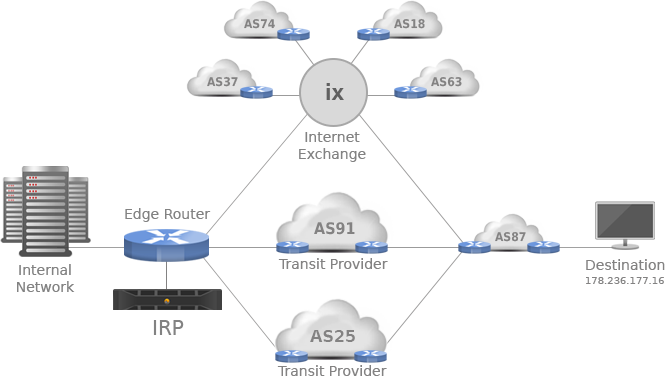There are various techniques for optimizing traffic routing across multiple transit providers available in a network. However, there are some additional challenges when there are connections to Internet Exchanges within the multi-homed blend. When looking to choose the best performing peer to send the traffic through, the main challenge is figuring out the peer/s that can reach the destination and actively probing it/them for network performance metrics such as latency and packet loss. In this article we describe how this process has been fully automated in Noction IRP 2.1.
A transit provider can deliver traffic to any destination on the Internet. However, within an Internet Exchange, a peering partner gives access only to the set of prefixes originated or transiting its network. Therefore, when IRP evaluates the Exchange as a best path, it has to know the prefixes announced by each peer, to avoid inefficient probing of paths that cannot lead to the desired destination. With this purpose, IRP gets the routing table from the edge router containing the list of IPs and the corresponding next-hop; this represents the next router’s IP address which a packet is sent to as it traverses a network on its journey to the final destination. IRP matches the prefix with the corresponding next-hop among the configured peers, allowing it to select for probing only those peers that have access to a specific prefix. This process is also performed in the case of a transit provider that gives access only to a limited set of prefixes, rather than the entire Internet.

IRP configuration in a multi-homed network connected to transit providers as well as an Internet Exchange
In the case of multiple transit providers, there is an additional IP alias added on the IRP platform for each provider. The edge router is configured in such a way that traffic originating from each of these IPs is routed over different providers. This is done with the help of Policy Based Routing (PBR). With PBR, a network engineer has the ability to dictate the routing behavior based on a number of different criteria other than the destination network. These PBR rules are applied to make sure that IRP probes are following the destined paths. However, when it comes to Internet Exchanges, configuring hundreds of IP aliases on the platform would result in inefficient IP address usage and an unmanageable setup. To avoid this, a set of PBR rules is applied making sure that the probes to be sent through a specific provider are originating from one of the configured IPs with a specific DSCP code assigned. DSCP – Differentiated Services Code Point – is a field in an IP packet that enables different levels of service to be assigned to network traffic. Since DSCP can take up to 64 different values, one configured IP can be associated with up to 64 peers. Although, due to this mechanism, the number of required IP addresses for aliases to be configured has considerably decreased, hard work would still be needed to configure the PBR on the edge router as described above. To solve this, IRP implemented a built-in PBR config-generator which provides the configuration code to be used for a specific router model. By running this generated set of commands, network administrators can easily configure the required PBR rules on the router.










